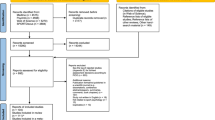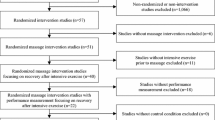Abstract
Background and aims: The objective of this non-randomized study was to determine the influence of a specific physical activity program on the postural stability of older people. Methods: Seventy-four subjects (72.4±0.7 yrs) participated in an individualized three-month physical activity program designed to improve posture, balance and mobility — the PBM program. Sessions were held twice weekly. Postural stability was assessed using a force platform, subjects being in static and dynamic conditions, and with open and closed eyes. Changes in stabilometric parameters (Sway area, ML mean, AP mean, Total length, ML length and AP length) of the intervention group were compared to those of 14 control subjects (71.8±1.5 years). Results: A two-way analysis of variance with repeated measures did not show any significant post-program change in postural stability in the hard floor condition. In contrast, Sway area (p<0.0005), Total length (p<0.001) and AP length (p<0.01) were significantly reduced after the training program in the foam floor condition, with open and closed eyes. In addition, in the mediolateral axis condition and with closed eyes, AP length in the intervention group was significantly reduced (p<0.01, and in the antero-posterior axis condition with both open and closed eyes, Sway area (p<0.0005), Total length (p<0.0005) and AP length (p<0.05) decreased significantly. Conclusions: As shown by the results in the foam floor and dynamic conditions, our individualized physical activity program improved the postural stability of older people when the standing position was challenged. However, the lack of significant results for the hard floor condition suggests that three months is not sufficient to improve static balance. The PBM physical activity program can be used for balance training in older people, but further studies are required to determine the time needed to effect improvements in static balance in this population.
Similar content being viewed by others
References
Alexander NB. Postural control in older adults. J Am Geriatr Soc 1994; 42: 93–108.
Tinetti ME. Performance-oriented assessment of mobility problems in elderly patients. J Am Geriatr Soc 1986; 34: 119–26.
Horak FB, Shupert CL, Mirka A. Components of postural dyscontrol in the elderly: a review. Neurobiol Aging 1989; 10: 727–38.
American College of Sports Medicine. Position Stand. Exercise and physical activity for older adults. Med Sci Sports Exerc 1998; 30: 992–1008.
Hunter GR, Treuth MS, Weinsier RL, et al. The effects of strength conditioning on older women’s ability to perform daily tasks. J Am Geriatr Soc 1995; 43: 756–60.
Sauvage LR, Myklebust BM, Crow-Pan J, et al. A clinical trial of strengthening and aerobic exercise to improve gait and balance in elderly male nursing home residents. Am J Phys Med Rehabil 1992; 71: 333–42.
Chandler JM, Duncan PW, Kochersberger G, Studenski S. Is lower extremity strength gain associated with improvement in physical performance and disability in frail, community-dwelling elders? Arch Phys Med Rehabil 1998; 79: 24–30.
Province MA, Hadley EC, Hornbrook MC, et al. The effects of exercise on falls in elderly patients. A preplanned meta-analysis of the FICSIT trials. Frailty and injuries: cooperative studies of intervention techniques. JAMA 1995; 273: 1341–7.
Hu MH, Woollacott MH. Multisensory training of standing balance in older adults: I. Postural stability and one-leg stance balance. J Gerontol 1994; 49: M52–61.
Judge JO, Lindsey C, Underwood M, Winsemius D. Balance improvements in older women: effects of exercise training. Phys Ther 1993; 73: 254–62.
Topp R, Mikesky A, Wigglesworth J, Holt W Jr, Edwards JE. The effect of a 12-week dynamic resistance strength training program on gait velocity and balance of older adults. Gerontologist 1993; 33: 501–6.
Johansson G, Jarnlo B. Balance training in 70-year-old women. Phys Ther 1991; 7: 121–5.
Crilly RG, Willems DA, Trenholm KJ, Hayes KC, Delaquerriere-Richardson LF. Effect of exercise on postural sway in the elderly. Gerontology 1989; 35: 137–43.
Lichtenstein MJ, Shields SL, Shiavi RG, Burger C. Exercise and balance in aged women: a pilot controlled clinical trial. Arch Phys Med Rehabil 1989; 70: 138–43.
Lord SR, Ward JA, Williams P. Exercise effect on dynamic stability in older women: a randomized controlled trial. Arch Phys Med Rehabil 1996; 77: 232–6.
Ledin T, Kronhed AC, Moller C, Moller M, Odkvist LM, Olsson B. Effects of balance training in elderly evaluated by clinical tests and dynamic posturography. J Vestib Res 1990–1; 1: 129–8.
Buchner DM, Cress ME, de Lateur BJ, et al. The effect of strength and endurance training on gait, balance, fall risk, and health services use in community-living older adults. J Gerontol 1997; 52: M218–24.
Seidler RD, Martin PE. The effects of short-term balance training on the postural control of older adults. Gait Posture 1997; 6: 224–36.
Patla AE, Frank JS, Winter DA. Balance control in the elderly: implications for clinical assessment and rehabilitation. Can J Public Health 1992; 83 (Suppl 2): S29–33.
Boyette LW, Lloyd A, Manuel S, Boyette JE, Echt KV. Development of an exercise expert system for older adults. J Rehabil Res Dev 2001; 38: 79–91.
Hue O, Ledrole D, Seynnes O, Bernard PL. Influence of a typical “Posture-Balance-Mobility” motor practice on the postural capacities of elderly people. Ann Réadaptation Méd Phys 2001; 44: 81–8 (in French).
Seynnes O, Hue O, Ledrole D, Bernard PL. Adapted physical activity in old age: effects of a low intensity training program on isokinetic power and fatigability. Aging Clin Exp Res 2002; 14: 491–8.
Wu G, Chiang JH. The effects of surface compliance on foot pressure in stance. Gait Posture 1996; 4: 122–9.
Chiang JH, Wu G. The influence of foam surfaces on biomechanical variables contributing to postural control. Gait Posture 1997; 5: 239–45.
Golomer E, Dupui P, Monod H. Sex-linked differences in equilibrium reactions among adolescents performing complex sensorimotor tasks. J Physiology (Paris) 1997; 91: 49–55.
Rooks DS, Kiel DP, Parsons C, Hayes WC. Self-paced resistance training and walking exercise in community-dwelling older adults: effects on neuromotor performance. J Gerontol 1997; 52: M161–8.
Corriveau H, Hebert R, Prince F, Raiche M. Postural control in the elderly: an analysis of test-retest and interrater reliability of the COP-COM variable. Arch Phys Med Rehabil 2001; 82: 80–5.
Owings TM, Pavol MJ, Foley KT, Grabiner MD. Measures of postural stability are not predictors of recovery from large postural disturbances in healthy older adults. J Am Geriatr Soc 2000; 48: 42–50.
Lord SR, Castell S. Physical activity program for older persons: effect on balance, strength, neuromuscular control, and reaction time. Arch Phys Med Rehabil 1994; 75: 648–52.
Woollacott MH, Shumway-Cook A, Nashner LM. Aging and posture control: changes in sensory organization and muscular coordination. Int J Aging Hum Dev 1986; 23: 97–114.
Author information
Authors and Affiliations
Corresponding author
Rights and permissions
About this article
Cite this article
Hue, O.A., Seynnes, O., Ledrole, D. et al. Effects of a physical activity program on postural stability in older people. Aging Clin Exp Res 16, 356–362 (2004). https://doi.org/10.1007/BF03324564
Received:
Accepted:
Published:
Issue Date:
DOI: https://doi.org/10.1007/BF03324564




